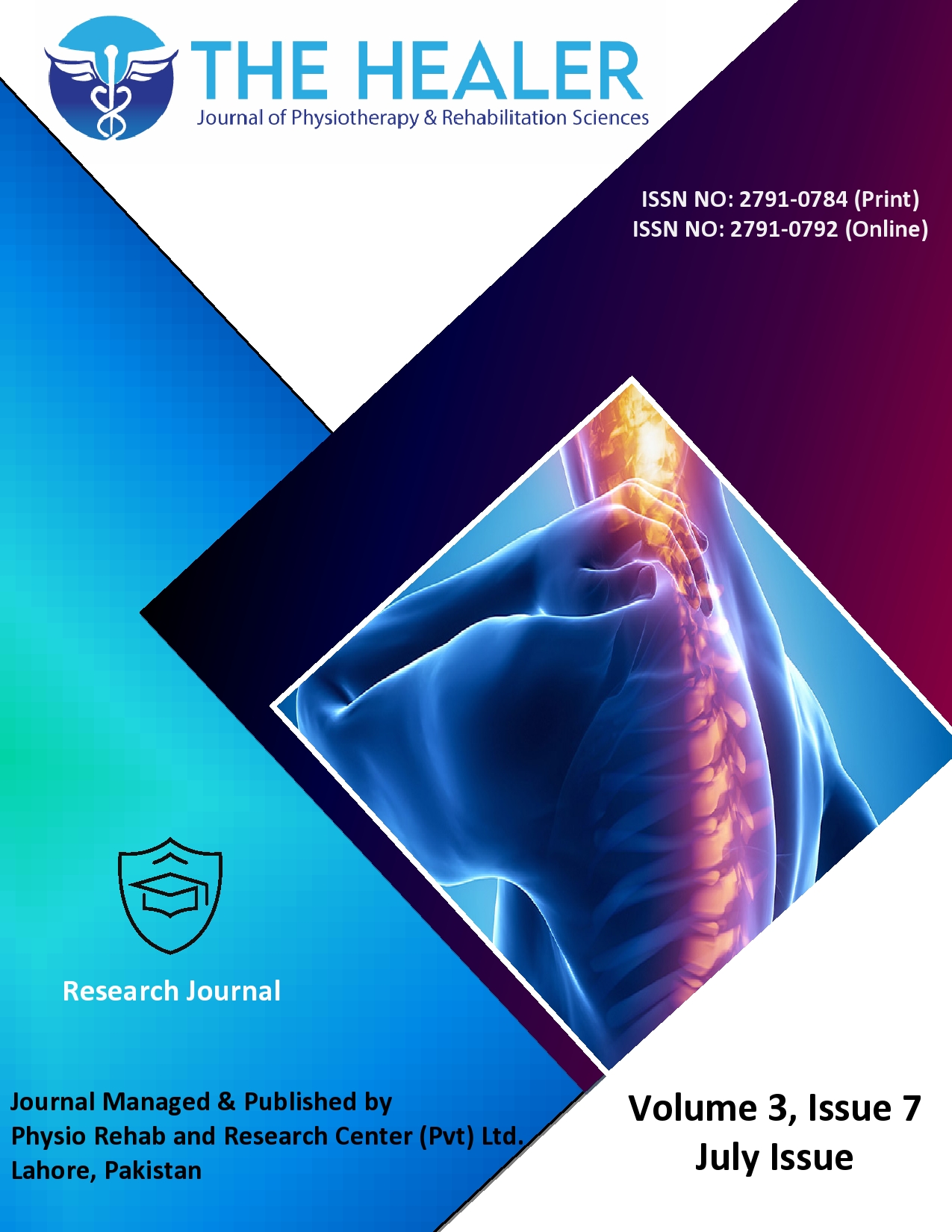Effects of Routine Physical Therapy with and without Pilates-based Core Stability Exercises on Gait, Function and Balance in Patients with Multiple Sclerosis
Pilates-based Core Stability Exercises in Multiple Sclerosis
DOI:
https://doi.org/10.55735/hjprs.v3i7.166Keywords:
core-stability, gait, physical therapy, pilates, multiple sclerosisAbstract
Background: In multiple sclerosis, the immune system erroneously assaults and harms the protective myelin and this can cause a variety of symptoms such as muscle weakness, coordination difficulties, vision disturbances and chronic pain. Objective: To determine the effects of routine physical therapy with and without Pilates-based core stability exercises on gait, function and balance in ambulant multiple sclerosis. Methods: A randomized controlled trial was conducted at the Afeera Saleem Physiotherapy Clinic in Gujranwala, Pakistan and completed within nine months, after the approval of the synopsis. The sample size for this study was calculated to be 74 with 37 individuals in each group, using non-probability purposive sampling for the selection of sample. Patients with multiple sclerosis, meeting the McDonald’s criteria, aged 18 years or over, able to walk independently with or without assistive devices such as a walking stick or orthotic brace and both males and females were included. Patients having pathology or recent injury of the lower extremity, lumbar radiculopathy, systematic diseases, congenital deformity or having scores less than 6 on the truncated mental test were excluded. The qualitative data was presented as frequency and percentages. Results: This showed that there was a statistically significant difference in mean ranks between the Pilates group and routine physical therapy group at the post-intervention and follow-up time points (p-value 0.000). The Pilates group had a higher mean rank on the functional reach test measure at these time points compared to the routine physical therapy group at the post-intervention level, the mean ranks at the follow-up level, the mean ranks for the timed up and go test were 20.57 for the Pilates group and 54.43 for routine group, a p-value of 0.000, indicating a statistically significant difference between the two groups mean rank of 22.62 for the Pilates group and a mean rank of 52.38 for the routine physical therapy group (p-value 0.000). Conclusion: The results of this study suggest that the Pilates intervention was effective in improving timed up-and-go tests and expanded disability status scale scores for individuals with multiple sclerosis as compared to the routine physical therapy intervention.
Downloads
References
Dobson R, Giovannoni G. Multiple sclerosis–a review. European journal of neurology 2019; 26(1): 27-40.
Hosseinzadeh A, Baneshi M, Sedighi B, Kermanchi J, Haghdoost A. Incidence of multiple sclerosis in Iran: a nationwide, population-based study. Public Health 2019;
: 138-44.
Kamermans A, Planting KE, Jalink K, van Horssen J, de Vries HE. Reactive astrocytes in multiple sclerosis impair neuronal outgrowth through TRPM7‐mediated chondroitin sulfate proteoglycan production. Glia 2019; 67(1): 68-77.
Abasıyanık Z, Ertekin Ö, Kahraman T, Yigit P, Özakbaş S. The effects of Clinical Pilates training on walking, balance, fall risk, respiratory, and cognitive functions in persons with multiple sclerosis: A randomized controlled trial. Explore 2020; 16(1): 12-20.
Rodríguez-Fuentes G, Silveira-Pereira L, Ferradáns-Rodríguez P, Campo-Prieto P. Therapeutic Effects of the Pilates Method in Patients with Multiple Sclerosis: A Systematic Review. Journal of Clinical Medicine 2022; 11(3): 683.
Hosswini AH, Sedaghati P. The effect of eight weeks of Pilates exercises and myofascial release on balance, trunk muscle endurance and flexibility in people with multiple sclerosis. Studies in Sport Medicine 2022; 13(30): 159-84.
Arik MI, Kiloatar H, Saracoglu I. Do Pilates exercises improve balance in patients with multiple sclerosis? A systematic review and meta-analysis. Multiple Sclerosis and Related Disorders 2022; 57: 103410.
Güngör F, Tarakci E, Özdemir-Acar Z, Soysal A. The effects of supervised versus home Pilates-based core stability training on lower extremity muscle strength and postural sway in people with multiple sclerosis. Multiple Sclerosis Journal 2022; 28(2): 269-79.
Lahdenperä S, Soilu‐Hänninen M, Kuusisto HM, Atula S, Junnila J, Berglund A. Medication adherence/persistence among patients with active multiple sclerosis in Finland. Acta Neurologica Scandinavica 2020;
(6): 605-12.
Kalb R, Brown TR, Coote S, et al. Exercise and lifestyle physical activity recommendations for people with multiple sclerosis throughout the disease course. Multiple Sclerosis Journal 2020; 26(12): 1459-69.
Brull A, Zubizarreta A, Cabanes I, Rodriguez-Larrad A. Sensorized tip for monitoring people with multiple sclerosis that require assistive devices for walking. Sensors 2020; 20(15): 4329.
Sánchez-Lastra MA, Martínez-Aldao D, Molina AJ, Ayán C. Pilates for people with multiple sclerosis: A systematic review and meta-analysis. Multiple sclerosis and related disorders 2019; 28: 199-212.
Amedoro A, Berardi A, Conte A, et al. The effect of aquatic physical therapy on patients with multiple sclerosis: a systematic review and meta-analysis. Multiple sclerosis and related disorders 2020; 41: 102022.
Arntzen EC, Straume BK, Odeh F, Feys P, Zanaboni P, Normann B. Group-based individualized comprehensive core stability intervention improves balance in persons with multiple sclerosis: A randomized controlled trial. Physical therapy 2019; 99(8): 1027-38.
Fox EE, Hough AD, Creanor S, Gear M, Freeman JAJPt. Effects of pilates-based core stability training in ambulant people with multiple sclerosis: multicenter, assessor-blinded, randomized controlled trial. 2016; 96(8): 1170-8.
Kalron A, Rosenblum U, Frid L, Achiron AJCr. Pilates exercise training vs. physical therapy for improving walking and balance in people with multiple sclerosis: A randomized controlled trial. 2017; 31(3): 319-28.
Simonsen CS, Flemmen HØ, Broch L, et al. The course of multiple sclerosis rewritten: a Norwegian population-based study on disease demographics and progression. Journal of neurology 2021; 268(4): 1330-41.
Duff WR, Andrushko JW, Renshaw DW, et al. Impact of pilates exercise in multiple sclerosis: a randomized controlled trial. 2018; 20(2): 92-100.

Downloads
Published
License
Copyright (c) 2023 The Healer Journal of Physiotherapy and Rehabilitation Sciences

This work is licensed under a Creative Commons Attribution 4.0 International License.













